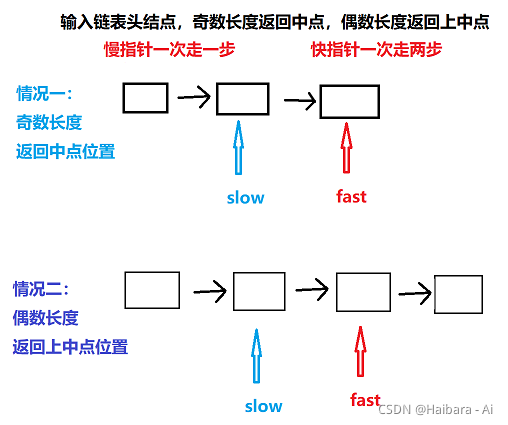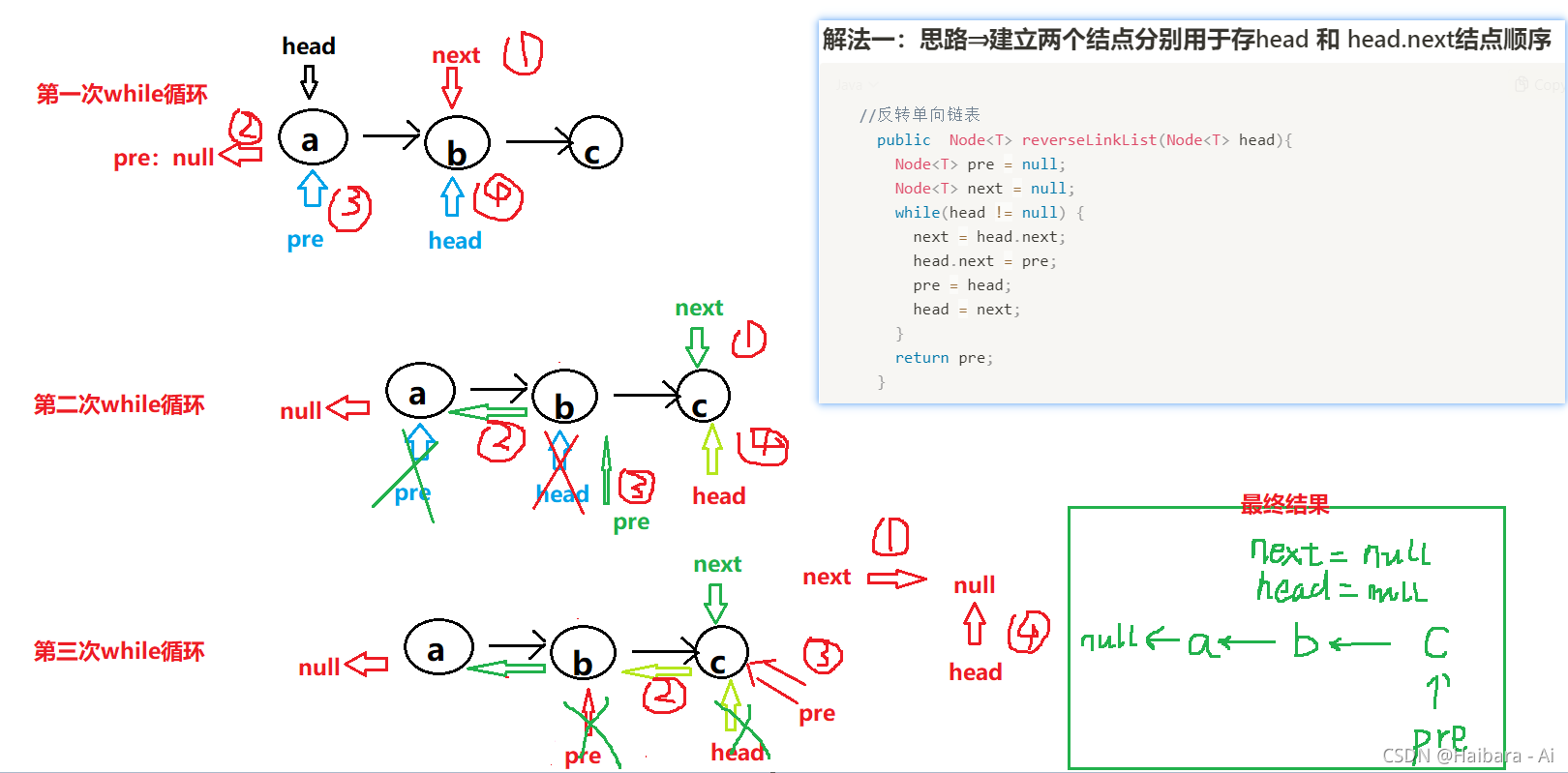一:面试时链表解题的方法论
1、对于笔试,不用太在乎空间复杂度,一切为了时间复杂度
2、对于面试,时间复杂度依然放在第一位,但是一定要找到空间最省的方法
二:链表面试题常用数据结构和技巧
1、使用容器(哈希表、数组等)
2、快慢指针
使用快慢指针的面试题:
- 1、输入链表头结点,奇数长度返回中点,偶数长度返回上中点
*
//输入链表头结点,奇数长度返回中点,偶数长度返回上中点
public static <T> Node<T> midOrUpMidNode(Node<T> head) {
//如果当前结点为空 或者 结点的下一个结点为空 或者结点的下一个结点的下一个结点为空
if(head == null || head.next == null || head.next.next == null) {
return head;
}
//此时链表至少3个结点
Node<T> slow = head.next;
Node<T> fast = head.next.next;
/*
如果快指针后面还有两个结点
慢指针一次走一步
快指针一次走两步
*/
while(fast.next != null && fast.next.next != null) {
slow = slow.next;
fast = fast.next.next;
}
return slow;
}
- 2、输入链表头结点,奇数长度返回中点,偶数长度返回下中点
//输入链表头结点,奇数长度返回中点,偶数长度返回下中点
public static <T> Node<T> midOrDownMidNode(Node<T> head) {
// 如果当前结点为空 或 结点的下一个结点为空
if(head == null || head.next == null) {
return head;
}
//此时链表至少2个结点
Node<T> slow = head.next;
Node<T> fast = head.next;
/*
如果快指针后面还有两个结点
慢指针一次走一步
快指针一次走两步
*/
while(fast.next != null && fast.next.next != null) {
slow = slow.next;
fast = fast.next.next;
}
return slow;
}
- 3、输入链表头节点,奇数长度返回中点前一个,偶数长度返回上中点前一个
//输入链表头节点,奇数长度返回中点前一个,偶数长度返回上中点前一个
public static <T> Node<T> midOrUpMidPreNode(Node<T> head) {
//如果当前结点为空 或者 结点的下一个结点为空 或者结点的下一个结点的下一个结点为空
if(head == null || head.next == null || head.next.next == null) {
return null;
}
//此时链表至少3个结点
Node<T> slow = head;
Node<T> fast = head.next.next;
/*
如果快指针后面还有两个结点
慢指针一次走一步
快指针一次走两步
*/
while(fast.next != null && fast.next.next != null) {
slow = slow.next;
fast = fast.next.next;
}
return slow;
}
- 4、输入链表头节点,奇数长度返回中点前一个,偶数长度返回下中点前一个
//输入链表头节点,奇数长度返回中点前一个,偶数长度返回下中点前一个
public static <T> Node<T> midOrDownMidPreNode(Node<T> head){
// 如果当前结点为空 或 结点的下一个结点为空
if(head == null || head.next == null) {
return null;
}
//如果结点的下一个结点的下一个结点为空
if(head.next.next == null) {
return head;
}
//此时链表至少3个结点
Node slow = head;
Node fast = head.next;
/*
如果快指针后面还有两个结点
慢指针一次走一步
快指针一次走两步
*/
while(fast.next != null && fast.next.next != null) {
slow = slow.next;
fast = fast.next.next;
}
return slow;
}
面试题三:反转单链表
思路?建立两个结点分别用于存head 和 head.next结点顺序

//反转单向链表
public Node<T> reverseLinkList(Node<T> head){
Node<T> pre = null;
Node<T> next = null;
while(head != null) {
next = head.next;
head.next = pre;
pre = head;
head = next;
}
return pre;
}
面试题四:反转双向链表
public Node<T> reverseDoubleLinked(Node<T> head){
head = head.next; //将head指向第一个结点
Node<T> pre = null;
Node<T> next = null;
while(head != null) {
next = head.next; //next存放当前结点的下一个
head.next = pre; //当前结点的下一个指向前面
head.previous = next; //当前结点的前一个指向后面
pre = head; //当前结点变成前结点
head = next; //结点后移:从头到尾 next充当临时变量
}
return pre;
}
面试题五:从单链表中删除指定元素
//从单链表中删除指定元素
public Node<T> deleteTargetNode(Node<T> head,T target){
//首先 先找出第一个不是目标的结点作为head
while(head.getData() != null) {
if(head.getData() == target) {
head = head.next;
}else {
break;
}
}
Node<T> pre = head;
Node<T> cur = head;
//此时head 肯定不是target
while(cur != null) {
if(cur.getData() == target) {
pre.next = cur.next;//跳过
}else {
pre = cur;
}
cur = cur.next; //最后再将cur后移
}
return head;
}
面试题六:从双向链表中删除指定元素
//从双向链表中删除指定元素
public Node<T> deleteTargetNode(Node<T> head,T target){
//找到第一个不是target的元素作为head
while(head!=null) {
if(head.getData()!=target) {
break;
}
head = head.next;
}
head.previous = null;
Node<T> pre = head;
Node<T> cur = head;
while(cur!=null) {
if(cur.getData().equals(target)) {
pre.next = cur.next;
//判断是否为最后一个元素
if(cur.next!=null) {
cur.next.previous = pre;
}
}else {
pre = cur;
}
cur = cur.next;
}
return head;
}
面试题七:判断一个链表是否为回文结构
例子: 1 → 2 → 1 返回true 1 → 2 → 2 → 1 返回true 1 → 2 → 3 返回false
如果链表长度为N,时间复杂度为O(N),额外空间复杂度O(1)
笔试用栈,面试用改链表方法(利用有限几个变量 空间O(1))
版本一:利用栈 空间O(N)
//利用栈 空间O(N)
public static <T> boolean checkByStack(Node<T> head) {
//判断链表是否为空 或 长度为1
if(head == null || head.next == null) {
return true;
}
Stack<Node<T>> stack = new Stack<>();
Node<T> p = head;
Node<T> q = head;
while(p!=null) {
stack.add(p);
p = p.next;
}
while(!stack.isEmpty()) {
if(!stack.pop().getData().equals(q.getData())) {
return false;
}
q = q.next;
}
return true;
}
版本二:利用栈 空间O(N/2)
//利用栈 空间O(N/2)
public static <T> boolean checkByStackPlus(Node<T> head) {
//判断链表是否为空 或 长度为1
if(head == null || head.next == null) {
return true;
}
//快慢指针优化 只存一半的内容进栈
Node<T> fast = head; // 一次走两步
Node<T> slow = head; // 一次走一步
Node<T> q = head;
while(fast.next!=null && fast.next.next != null) {
slow = slow.next;
fast = fast.next.next;
}
Stack<Node<T>> stack = new Stack<>();
while(slow.next != null) {
stack.add(slow.next);
slow = slow.next;
}
while(!stack.isEmpty()) {
if(!stack.pop().getData().equals(q.getData())) {
return false;
}
q = q.next;
}
return true;
}
版本三:利用有限几个变量 空间O(1)
/*利用有限几个变量 空间O(1)*/
public static <T> boolean checkByVar(Node<T> head) {
//判断链表是否为空 或 长度为1
if(head == null || head.next == null) {
return true;
}
//快慢指针优化
Node<T> fast = head; // 一次走两步
Node<T> slow = head; // 一次走一步
while(fast.next != null && fast.next.next != null) {//找中点
slow = slow.next; // mid
fast = fast.next.next; // end
}
fast = slow.next; //当前slow是中点 将fast变成是右半部分的第一个结点
slow.next = null; //将慢指针(当前指向mid)指向null 前半段结束
Node<T> rightPartFirstNode = null;
//开始将后半段逆序 连到中点上
while(fast != null) {
rightPartFirstNode = fast.next; //保存 下一个结点
fast.next = slow; //修改fast的下一个结点
slow = fast; //slow移动
fast = rightPartFirstNode; //fast移动
}
//当前只有slow指针指在链表最后一个元素的位置
rightPartFirstNode = slow; //用结点保存 最后结点
//然后slow跟fast指针才能往mid走
fast = head; //让fast成为头结点
boolean res = true;
while(slow != null && fast != null) { //检查 判断条件
if(slow.getData() != fast.getData()) {
res = false; //这里不着急return 是因为还得将链表变为原样
break;
}
slow = slow.next; //slow 移动至 mid
fast = fast.next; //fast 移动至 mid
}
//退出此while循环时,fast指向null,slow指向mid
//下面开始复原链表
slow = rightPartFirstNode.next;
rightPartFirstNode.next = null;
while(slow != null) {
//当slow到达mid的时候 此时他的next就为null
fast = slow.next;
slow.next = rightPartFirstNode;
rightPartFirstNode = slow;
slow = fast;
}
return res;
}
面试题八:把单向链表按某值划分成左边小、中间相等、右边大的形式
1、把链表放入数组里面,在数组上做partition(笔试用)时间复杂度O(N)
//1、把链表放入数组里面,在数组上做partition(笔试用)
public static <T> Node<T> listPartition(Node<T> head, int target){
if(head == null) {
return head;
}
Node<T> cur = head;//cur设为头结点
//求链表元素个数 为了生成数组
int i = 0;
while(cur != null) {
i++;
cur = cur.next;
}
Node<T>[] nodeArr = new Node[i];
i = 0;
cur = head;
//遍历往数组中存值
for(i = 0; i != nodeArr.length; i++) {
nodeArr[i] = cur;
cur = cur.next;
}
//做partition
arrPartition(nodeArr,target);
//此时数组已经按预期排好了 下面开始连接结点
for(i = 1; i != nodeArr.length; i++) {
nodeArr[i -1].next = nodeArr[i];
}
//最后一个结点的next指针 指向null
nodeArr[i -1].next = null;
//返回头结点
return nodeArr[0];
}
public static <T> void arrPartition(Node<T>[] nodeArr,int target) {
int small = -1;
int big = nodeArr.length;
int index = 0 ;
while(index != big) {
if((int)nodeArr[index].data < target) {
swap(nodeArr,++small,index++); //自己和自己交换
}else if((int)nodeArr[index].data == target) {
index++; //index++ 直接后移
}else {
swap(nodeArr,--big,index); //当前数和最后的数做交换
}
}
}
public static <T> void swap(Node<T>[] arr,int x,int y) {
Node<T> node = arr[x];
arr[x] = arr[y];
arr[y] = node;
}
2、分成小、中、大 三部分,再把各个部分之间串起来(面试用)
时间复杂度O(N)空间复杂度O(1)
public static <T> Node<T> linkPartition(Node<T> head, int target){
Node<T> sH = null; //小于部分的头指针
Node<T> sT = null; //小于部分的尾指针
Node<T> eH = null; //等于部分的头指针
Node<T> eT = null; //等于部分的尾指针
Node<T> mH = null; //大于部分的头指针
Node<T> mT = null; //大于部分的尾指针
Node<T> next = null; //额外变量
while(head != null) {
next = head.next;
if((int)head.data < target) {
if(sH == null) { //如果当前小于部分的头指针为空
sH = head; //小于部分的头尾指针都指向此结点
sT = head;
}else { //如果当前小于部分的头指针不为空
sT.next = head; //小于部分的头尾指针的next指向此结点
sT = head; //尾指针后移
}
}else if((int)head.data == target) {
if(eH == null) { //如果当前等于部分的头指针为空
eH = head; //等于部分的头尾指针都指向此结点
eT = head;
}else { //如果当前等于部分的头指针不为空
eT.next = head; //等于部分的头尾指针的next指向此结点
eT = head; //尾指针后移
}
}else {
if(mH == null) { //如果当前大于部分的头指针为空
mH = head; //大于部分的头尾指针都指向此结点
mT = head;
}else { //如果当前大于部分的头指针不为空
mT.next = head; //大于部分的头尾指针的next指向此结点
mT = head; //尾指针后移
}
}
head = next;
}
//开始连接各部分
if(sT != null) { //如果有小于区域
sT.next = eH;
eT = eT == null ? sT : eT; // 下一步,谁去连大于区域的头,谁就变成eT
}
if(eT != null) { //如果有等于区域
eT.next = mH;
}
//最后返回所以链表串起来的最左结点
return sH != null ? sH : (eH != null ? eH : mH);
}
面试题九:给定一个由Node结点类型组成的无环单链表的头结点head,请实现一个函数完成这个链表的复制
一种特殊的单链表结点类描述如下
public static class Node{
int value;
Node next;
Node rand;
public Node(int val){
value = val;
}
}
rand指针是单链表结点结构中新增的指针,rand 可能指向链表中的任意一个结点,也可能指向null
给定一个由Node结点类型组成的无环单链表的头结点head
请实现一个函数完成这个链表的复制,并返回复制的新链表的头结点
要求:空间复杂度O(N)、额外空间复杂度O(1)

笔试:用HashMap解决
//1、使用HashMap存储
public static Node copyListWithRandByHashMap(Node head) {
Map<Node,Node> map = new HashMap<>();
Node cur = head;
//第一次循环 存入新Node
while(cur != null) {
map.put(cur, new Node(cur.value));
cur = cur.next;
}
cur = head;
//第二次循环 为新Node串指针
while(cur != null) {
// cur 是老结点 map.get(cur)为新结点
map.get(cur).next = map.get(cur.next); //新结点的next指针
map.get(cur).rand = map.get(cur.rand); //新结点的rand指针
cur = cur.next;
}
//返回 head` 结点
return map.get(head);
}
面试:直接在每个结点后面新增该结点 用位置来解决指针指向问题
//2、直接在每个结点后面新增该结点 用位置来解决指针指向问题
public static Node copyListWithRand(Node head) {
if(head == null) {
return null;
}
Node cur = head;
Node next = null;
//第一次循环 对链表中每个结点进行复制 1 -> 2 ==> 1 -> 1` -> 2 -> 2`
while(cur != null) {
next = cur.next; //2
cur.next = new Node(cur.value); //1 -> 1`
cur.next.next = next; //1 -> 1` -> 2
cur = next; //cur = 2
}
cur = head;
Node curCopy = null;
//第二次循环 设置复制结点的rand 1 -> 1` -> 2 -> 2`
while(cur != null) {
next = cur.next.next; // 2
curCopy = cur.next; // 1`
curCopy.rand = cur.rand != null? cur.rand.next : null;
cur = next;
}
//开始分离node`结点
Node resHead = head.next; //此时就是head`结点
cur = head;
while(cur != null) { //1 -> 1` -> 2 -> 2`
next = cur.next.next; //2
curCopy = cur.next; //1`
cur.next = next; //1.next = 2
curCopy.next = next!=null? next.next : null;
cur = next;
}
return resHead;
}
面试题十:两个单链表相交的一系列问题
给定两个可能有环也可能无环的单链表,头结点head1 和 head2。
请实现一个函数,如果两个链表相交,请返回相交的 第一个结点。如果不相交,返回null
要求:如果两个链表长度之和为N,时间复杂度语法到O(N),额外空间复杂度,请达到O(1)
分成三种情况
-
1、情况一:两个链表都无环,如果相交,返回第一个相交结点,如果不相交,返回null

-
2、情况二:两个链表 如果一个有环 一个没有 这是不可能相交的 return null
-
3、情况三:两个链表都有环
- 3-1:如果不相交,返回null
![[外链图片转存失败,源站可能有防盗链机制,建议将图片保存下来直接上传(img-hsBtVGih-1633959972336)(https://s3-us-west-2.amazonaws.com/secure.notion-static.com/79fec707-aa4d-490c-86b6-2172e2adf9ff/Untitled.png)]](https://img-blog.csdnimg.cn/195d812d52294e758756c3e1a8b1f8a4.png?x-oss-process=image/watermark,type_ZHJvaWRzYW5zZmFsbGJhY2s,shadow_50,text_Q1NETiBASGFpYmFyYSAtIEFp,size_11,color_FFFFFF,t_70,g_se,x_16)
- 3-2:如果相交,他们肯定是共用环的
![[外链图片转存失败,源站可能有防盗链机制,建议将图片保存下来直接上传(img-ccYdXhw2-1633959972337)(https://s3-us-west-2.amazonaws.com/secure.notion-static.com/12158dd2-a415-4616-8d5a-ba9341d0d646/Untitled.png)]](https://img-blog.csdnimg.cn/5a63c99f1297432d93240971cdb132e4.png?x-oss-process=image/watermark,type_ZHJvaWRzYW5zZmFsbGJhY2s,shadow_50,text_Q1NETiBASGFpYmFyYSAtIEFp,size_20,color_FFFFFF,t_70,g_se,x_16)
判断单链表是否有环?
找到链表的第一个入环结点,如果无环,返回null
public static Node getLoopNode(Node head) {
if(head == null || head.next == null || head.next.next == null) {
return null;
}
//一开始让慢指针先走一步 快指针先走两步
Node slow = head.next;
Node fast = head.next.next;
//下次相遇时肯定已经走过入环结点了
while(slow != fast) {
//如果fast指针走到null 证明链表是一条单线
if(fast.next == null || fast.next.next == null) {
return null;
}
slow = slow.next;
fast = fast.next.next;
}
//此时两个指针已经过了入环结点 让快指针回到head
fast = head; //让慢指针停留在原地 快指针回到head
//让他们每次走一步 再相遇则是入环点
while(slow != fast) {
slow = slow.next;
fast = fast.next;
}
return slow;
}
目前就三种情况:
1、两个链表都无环
2、两个链表 一个有环 一个无环 这种情况 两个链表是不可能相交的
3、两个链表都有环
- 1、两个链表 各自独立 无相交结点
- 2、他俩的入环结点是一个,转变为无环链表的相交问题 base改变
- 3、让loop1循环 如果过程中没遇到loo2,那么就是情况3-1(两个链表 各自独立),反之就是情况3-3

//主函数 如果两个链表相交,返回相交的 第一个结点
public static Node getInterNode(Node head1,Node head2) {
if(head1 == null || head2 == null) {
return null;
}
Node loop1 = getLoopNode(head1);//找到链表head1 的第一个入环结点
Node loop2 = getLoopNode(head2);//找到链表head2 的第一个入环结点
//如果两个链表各自的入环结点都为空 证明 情况一
if(loop1 == null && loop2 == null) {
return noLoop(head1,head2);
}
//如果两个链表各自的入环结点都不为空 证明 情况三
if(loop1 != null && loop2 != null) {
return bothLoop(head1,loop1,head2,loop2);
}
//情况二:两个链表 如果一个有环 一个没有 这是不可能相交的 return null
return null;
}
//找到链表的第一个入环结点,如果无环,返回null
public static Node getLoopNode(Node head) {
if(head == null || head.next == null || head.next.next == null) {
return null;
}
//一开始让慢指针先走一步 快指针先走两步
Node slow = head.next;
Node fast = head.next.next;
//下次相遇时肯定已经走过入环结点了
while(slow != fast) {
//如果fast指针走到null 证明链表是一条单线
if(fast.next == null || fast.next.next == null) {
return null;
}
slow = slow.next;
fast = fast.next.next;
}
//此时两个指针已经过了入环结点 让快指针回到head
fast = head; //让慢指针停留在原地 快指针回到head
//让他们每次走一步 再相遇则是入环点
while(slow != fast) {
slow = slow.next;
fast = fast.next;
}
return slow;
}
//情况一:如果两个链表都无环,如果相交,返回第一个相交结点,如果不相交,返回null
public static Node noLoop(Node head1,Node head2) {
if(head1 == null || head2 == null) {
return null;
}
Node cur1 = head1;
Node cur2 = head2;
int len = 0; //记录两个链表的差值
//注意 cur1是走到最后一个结点 而不是 null
while( cur1.next != null) {
len ++;
cur1 = cur1.next;
}
//注意 cur2是走到最后一个结点 而不是 null
while(cur2.next != null) {
len --;
cur2 = cur2.next;
}
//此时len 就是 链表1和链表2 之间的差值
//如果此时 链表1的最后一个结点的内存地址 不等于 链表2的最后一个结点的话 证明 俩链表不相交
if(cur1 != cur2) {
return null;
}
cur1 = len > 0 ? head1 : head2; //如果len大于0 证明head1长度大于head2 谁长谁cur1
cur2 = (cur1 == head1) ? head2 : head1; //谁短,谁cur2
len = Math.abs(len); //len取绝对值
//长链表 先走len个长度
while(len != 0) {
len --;
cur1 = cur1.next;
}
//长链表和短链表一起走 再次相遇时 第一个相交结点就找到了
while(cur1 != cur2) {
cur1 = cur1.next;
cur2 = cur2.next;
}
return cur1;
}
//情况二:两个链表 如果一个有环 一个没有 这是不可能相交的
//情况三:如果两个链表都有环,如果相交,他们肯定是共用环的 返回第一个相交结点,如果不相交,返回null
public static Node bothLoop(Node head1,Node loop1,Node head2,Node loop2) {
Node cur1 = null;
Node cur2 = null;
if(loop1 == loop2) { //如果两个入环结点相同 证明是情况3-2:如果相交,他们肯定是共用环的
cur1 = head1;
cur2 = head2;
int len = 0; //两个链表的长度差值
//开始计算链表1的长度 注意此时条件是不等于 loop1 因为可以转换为无环链表相交问题
while(cur1 != loop1) {
len ++;
cur1 = cur1.next;
}
while(cur2 != loop2) {
len --;
cur2 = cur2.next;
}
cur1 = len > 0 ? head1 : head2; //谁长谁cur1
cur2 = (cur1 == head1) ? head2 : head1;//谁短谁cur2
len = Math.abs(len);
//长的链表先走len步
while(len != 0) {
len --;
cur1 = cur1.next;
}
//两个链表一起走
while(cur1 != cur2) {
cur1 = cur1.next;
cur2 = cur2.next;
}
//相遇则相交
return cur1;
}else { //证明是情况3-1 或 情况3-3
cur1 = loop1.next;
//往下走 如果遇到loop2证明3-3 相交 如果没遇到证明两个链表有环但没相交3-1
while(cur1 != loop1) {
if(cur1 == loop2) {
return loop1;//两个loop都算是相交的第一个结点
}
cur1 = cur1.next;
}
return null; //情况3-1 俩链表有环没相交
}
}